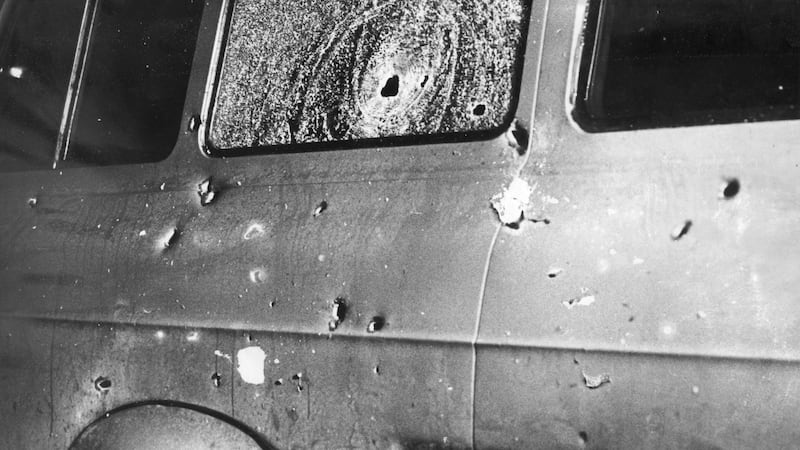The sole survivor of the 1976 IRA massacre at Kingsmill, Co Armagh, has told an inquest that he lay beneath his dying colleagues as they moaned in pain and fought for their lives after being shot.
Alan Black yesterday told of the incident in which 10 Protestant workmen, who he had been travelling home with on a minibus from a textile factory, were killed.
The bus was ambushed as it drove along the Whitecross to Bessbrook road on January 5th, 1976 – one of the most violent years of the Troubles. The attack was allegedly in reprisal for earlier loyalist killings.


Another man – a Catholic – cowered in a nearby field after he was ordered to flee, the hearing was told. As the victims lay there, the commander of the republican unit said: “Finish them off.”
More than five weeks have been set aside for the coroner’s inquiry into the Kingsmill shooting, which police described as the most senseless and savage killing of the early Troubles.
Truth and justice
Karen Armstrong, a sister of John Armstrong who died in the incident, said her brother “believed in truth and justice throughout his life” and that she hoped the truth about what happened would emerge during the inquest process.
“It is all we want and I think it is what we deserve,” she said.
Mr Black, a father of three, was shot several times during the ambush and said outside Belfast Coroner’s Court that he wanted the “unvarnished truth” to come out.
“This is a red-letter day for us to finally get our day in court,” he said.
The men’s minibus was stopped, and those on board were asked their religion by the gunmen.
The attackers, who were hidden in the hedges, ordered them to line up outside the van and they then opened fire.
The 10 who died were John Bryans, Robert Chambers, Reginald Chapman, Walter Chapman, Robert Freeburn, Joseph Lemmon, John McConville, James McWhirter, Robert Samuel Walker and Kenneth Worton.
Mr Black’s statement was read out by barrister Seán Doran during the inquest. He said the noise of the shooting was “deafening” as he fell on his face with another man collapsing across his legs. He could hear the moaning and groaning of his workmates.
A police report from the time, which was read to the coroner, said: “What happened then is perhaps the most savage and senseless single outrage in the present campaign. Fortunately it has not yet been paralleled.
“It resulted in 10 completely innocent workmen losing their lives and an 11th badly injured . . . One man escaped only because of his religion.”
Richard Hughes, the man who was ordered to flee, recalled the armed men asking which one was the Roman Catholic.
“The person on my right squeezed my hand,” the inquest heard. “I glanced out of the side of my eye. I did not move.”
Paramilitary group
The Kingsmill attack was claimed by a little-known republican paramilitary group considered to be a front for the supposedly-on-ceasefire IRA.
However, in 2011, the Historical Inquiries Team of independent detectives found the IRA had been responsible and had targeted the workmen because of their religion.
The inquest was ordered by Northern Ireland’s attorney general John Larkin QC.
Mr Doran told the hearing that two suspects linked to the killings were given On The Run “letters of comfort” from Tony Blair’s government as part of a deal with Sinn Féin during the peace process, to allow IRA members on the run, or wanted fugitives, back into Northern Ireland.
A total of 63 people were once suspected of involvement in the atrocity, the inquest heard, but no convictions were obtained even after a major review was carried out by police in 1986.
The Historical Inquiries Team of independent detectives later said early investigators missed opportunities.
Officers linked 11 weapons to the killing, nine of which were later found to be connected to 37 murders, 22 attempted murders and 19 non-fatal shootings, Mr Doran said.
Potential for mistakes
The Historical Inquiries Team acknowledged the work pressure the Royal Ulster Constabulary (RUC) was under at the time in the 1970s as the Troubles were at their fiercest.
But it said: “Senior levels within the RUC should have recognised the potential for the team to be overwhelmed and for mistakes to occur as a result.” – (PA)







